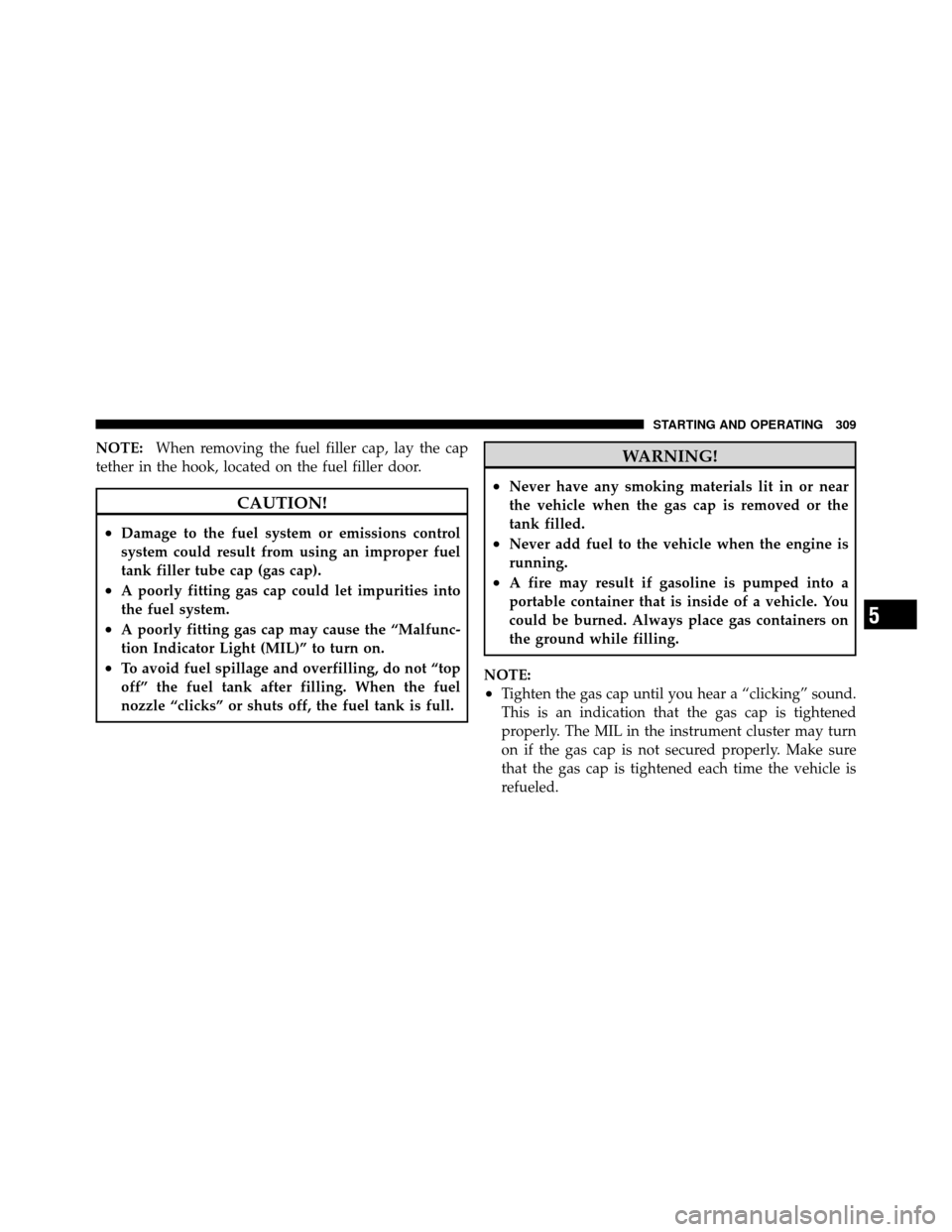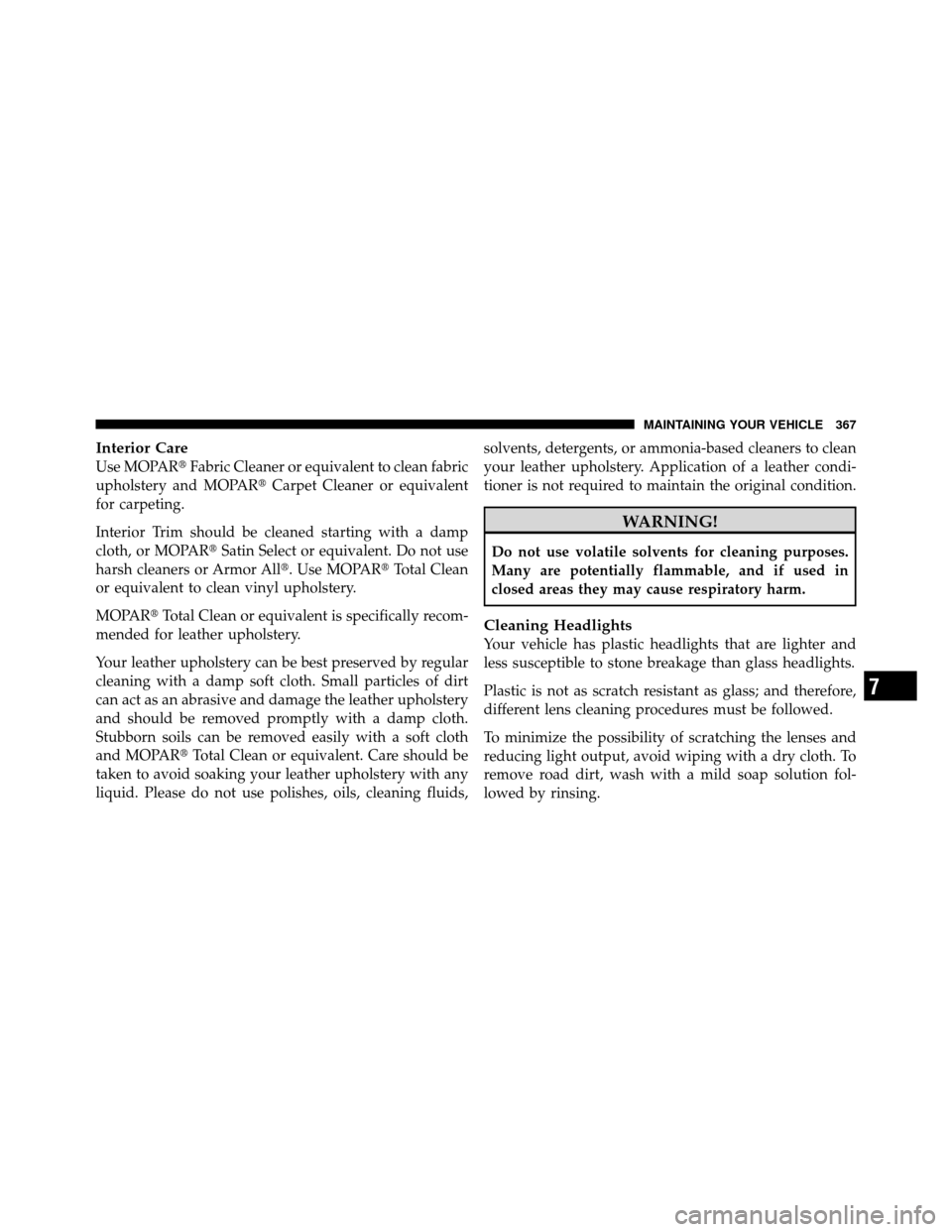Page 310 of 436

NOTE:When removing the fuel filler cap, lay the cap
tether in the hook, located on the fuel filler door.
CAUTION!
•Damage to the fuel system or emissions control
system could result from using an improper fuel
tank filler tube cap (gas cap).
•A poorly fitting gas cap could let impurities into
the fuel system.
•A poorly fitting gas cap may cause the “Malfunc-
tion Indicator Light (MIL)” to turn on.
•To avoid fuel spillage and overfilling, do not “top
off” the fuel tank after filling. When the fuel
nozzle “clicks” or shuts off, the fuel tank is full.
WARNING!
•Never have any smoking materials lit in or near
the vehicle when the gas cap is removed or the
tank filled.
•Never add fuel to the vehicle when the engine is
running.
•A fire may result if gasoline is pumped into a
portable container that is inside of a vehicle. You
could be burned. Always place gas containers on
the ground while filling.
NOTE:
•Tighten the gas cap until you hear a “clicking” sound.
This is an indication that the gas cap is tightened
properly. The MIL in the instrument cluster may turn
on if the gas cap is not secured properly. Make sure
that the gas cap is tightened each time the vehicle is
refueled.
5
STARTING AND OPERATING 309
Page 340 of 436

ONBOARD DIAGNOSTIC SYSTEM — OBD II
Your vehicle is equipped with a sophisticated onboard
diagnostic system called OBD II. This system monitors
the performance of the emissions, engine, and automatic
transmission control systems. When these systems are
operating properly, your vehicle will provide excellent
performance and fuel economy, as well as engine emis-
sions well within current government regulations.
If any of these systems require service, the OBD II system
will turn on the Malfunction Indicator Light (MIL). It will
also store diagnostic codes and other information to
assist your service technician in making repairs. Al-
though your vehicle will usually be drivable and not
need towing, see your authorized dealer for service as
soon as possible.CAUTION!
•Prolonged driving with the MIL on could cause
further damage to the emissions control system. It
could also affect fuel economy and driveability.
The vehicle must be serviced before any emissions
tests can be performed.
•If the MIL is flashing while the engine is running,
severe catalytic converter damage and power loss
will soon occur. Immediate service is required.
Loose Fuel Filler Cap
If the vehicle diagnostic system determines that the fuel
filler cap is loose, improperly installed, or damaged, a
”gASCAP” message will display in the odometer or a
“Check Gascap” message will display in the Electronic
Vehicle Information Center (EVIC) (if equipped). If this
occurs, tighten the fuel filler cap properly and press the
7
MAINTAINING YOUR VEHICLE 339
Page 341 of 436

Trip Odometer button to turn off the message. If the
problem continues, the message will appear the next time
the vehicle is started.
A loose, improperly installed, or damaged fuel filler cap
may also turn on the MIL.
EMISSIONS INSPECTION AND MAINTENANCE
PROGRAMS
In some localities, it may be a legal requirement to pass
an inspection of this vehicle’s emissions control system.
Failure to pass could prevent vehicle registration.For states that require an Inspection and Mainte-
nance (I/M), this check verifies the Malfunction
Indicator Light (MIL) is functioning and is not on
when the engine is running, and that the OBD II system
is ready for testing. Normally, the OBD II system will be ready. The OBD II
system may
notbe ready if the vehicle was recently
serviced, recently had a dead battery, or a battery replace-
ment. If the OBD II system should be determined not
ready for the I/M test, the vehicle may fail the test.
This vehicle has a simple ignition key-actuated test,
which you can use prior to going to the test station. To
check if this vehicle’s OBD II system is ready, you must
do the following:
1. Insert the key fob into the ignition switch.
2. Turn the ignition switch to the ON/RUN position, but
do not crank or start the engine.
3. If you crank or start the engine, you will have to start
this test over.
4. As soon as you turn the ignition switch to the ON/
RUN position, you will see the MIL symbol come on as
part of a normal bulb check.
340 MAINTAINING YOUR VEHICLE
Page 360 of 436

•Do not change the thermostat for Summer or Winter
operation. If replacement is ever necessary, install
ONLY the correct type thermostat. Other designs may
result in unsatisfactory coolant performance, poor gas
mileage, and increased emissions.
Brake System
In order to assure brake system performance, all brake
system components should be inspected periodically.
Refer to “Maintenance Schedule” for further information.
WARNING!
Riding the brakes can lead to brake failure and
possibly an accident. Driving with your foot resting
or riding on the brake pedal can result in abnormally
high brake temperatures, excessive lining wear, and
possible brake damage. You would not have your full
braking capacity in an emergency.
Master Cylinder – Brake Fluid Level Check
Check the fluid level in the master cylinder immediately
if the “Brake Warning Light” indicates system failure.
Check the fluid level in the master cylinder when per-
forming underhood services.
Clean the top of the master cylinder area before removing
the cap. Add fluid to bring the level up to the “MAX”
mark on the side of the master cylinder reservoir.
Overfilling of fluid is not recommended because it may
cause leaking in the system.
Add enough fluid to bring the level up to the require-
ments described on the brake fluid reservoir. With disc
brakes, fluid level can be expected to fall as the brake
pads wear. However, low fluid level may be caused by a
leak and a checkup may be needed.
7
MAINTAINING YOUR VEHICLE 359
Page 368 of 436

Interior Care
Use MOPAR�Fabric Cleaner or equivalent to clean fabric
upholstery and MOPAR� Carpet Cleaner or equivalent
for carpeting.
Interior Trim should be cleaned starting with a damp
cloth, or MOPAR� Satin Select or equivalent. Do not use
harsh cleaners or Armor All�. Use MOPAR� Total Clean
or equivalent to clean vinyl upholstery.
MOPAR� Total Clean or equivalent is specifically recom-
mended for leather upholstery.
Your leather upholstery can be best preserved by regular
cleaning with a damp soft cloth. Small particles of dirt
can act as an abrasive and damage the leather upholstery
and should be removed promptly with a damp cloth.
Stubborn soils can be removed easily with a soft cloth
and MOPAR� Total Clean or equivalent. Care should be
taken to avoid soaking your leather upholstery with any
liquid. Please do not use polishes, oils, cleaning fluids, solvents, detergents, or ammonia-based cleaners to clean
your leather upholstery. Application of a leather condi-
tioner is not required to maintain the original condition.
WARNING!
Do not use volatile solvents for cleaning purposes.
Many are potentially flammable, and if used in
closed areas they may cause respiratory harm.
Cleaning Headlights
Your vehicle has plastic headlights that are lighter and
less susceptible to stone breakage than glass headlights.
Plastic is not as scratch resistant as glass; and therefore,
different lens cleaning procedures must be followed.
To minimize the possibility of scratching the lenses and
reducing light output, avoid wiping with a dry cloth. To
remove road dirt, wash with a mild soap solution fol-
lowed by rinsing.
7
MAINTAINING YOUR VEHICLE 367
Page 374 of 436
Cav-
ityCartridge
Fuse Mini-
FuseDescription
6 — 20 Amp YellowFuel Pump
7 — 15 Amp BlueSub Amp – If Equipped
8 — 15 Amp BlueDiagnostic Link Connec-
tor (DLC)/Wireless Con-
trol Module (WCM)/
Wireless Ignition Node
(WIN)
9 — 20 Amp YellowPower Outlet
10 — — —
11 * ———
12 * ———
13 * ———Cav-
ity Cartridge
Fuse Mini-
FuseDescription
14 — 10 Amp RedAC Heater Control/
Cluster/Security Module
– If Equipped
15 — — —
16 — — —
17 — 20 Amp YellowCluster
18 — 20 Amp YellowSelectable Power Outlet
19 — 10 Amp RedStop Lights
20 — — —
21 — — —
22 — — —
23 — — —
24 — — —
7
MAINTAINING YOUR VEHICLE 373
Page 375 of 436
Cav-
ityCartridge
Fuse Mini-
FuseDescription
25 — — —
26 — — —
27 — 10 Amp RedOccupant Restraint
Controller (ORC)
28 — 10 Amp RedIgnition Run, AC Heater
Control/Occupant Re-
straint Controller (ORC)
29 — 5 Amp OrangeCluster/Electronic Stabil-
ity Program (ESP)/
Powertrain Control Mod-
ule (PCM)/STOP LIGHT
Switch
30 — 10 Amp RedDoor Modules/Power
Mirrors/Steering Control
Module (SCM)
31 — — —
32 — — —Cav-
ity Cartridge
Fuse Mini-
FuseDescription
33 — — —
34 — — —
35 — 5 Amp OrangeAntenna Module –
If Equipped/Power
Mirrors
36 — 25 Amp NaturalHands-Free Phone –
If Equipped/Radio/
Amplifier Feed
37 — 15 Amp BlueTransmission
38 — 10 Amp RedCargo Light/Vehicle
Information Module –
If Equipped
39 — 10 Amp RedHeated Mirrors –
If Equipped
374 MAINTAINING YOUR VEHICLE
Page 377 of 436

REPLACEMENT BULBS
LIGHT BULBS – InteriorBulb Number
Rear Courtesy/Reading Lamps ............. W5W
Rear Compartment (Trunk) Lamp ............. 562
Overhead Console Reading Lamps ............ 578
Visor Vanity Lamps ..................... A6220
Glove Box Lamp – If Equipped ............... 194
Door Courtesy .......................... 562
Shift Indicator Lamp ................. JKLE14140
Optional Door Map Pocket/
Cupholder ....... LED (Serviced at Authorized Dealer)
NOTE: For lighted switches, see your authorized dealer
for replacement instructions.
All of the interior bulbs are glass wedge base or glass
cartridge types. Aluminum base bulbs are not approved
and should not be used for replacement. LIGHT BULBS – Exterior
Bulb Number
Low Beam Headlamp – High Intensity
Discharge (HID) ......................... D1S
(Serviced at Authorized Dealer)
High Beam Headlamp .................... 9005
Front Park/Turn Lamp ................... 3157A
Front Fog Lamp ..................... 9145/H10
(Serviced at Authorized Dealer)
Front Side Marker ........................ 168
Tail Lamp ............................ 3057K
Tail/Stop/Turn Lamp ................... 3057K
Rear Side Marker ........................ 168
Backup Lamp ........................... 921
Center High-Mount Stop Lamp
(CHMSL) ............................. LED
(Serviced at Authorized Dealer)
License ................................ 168
376 MAINTAINING YOUR VEHICLE